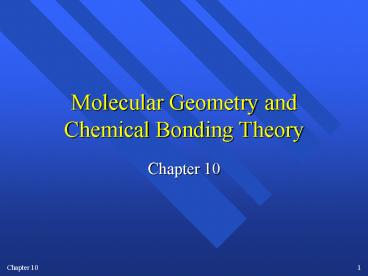Molecular Geometry and Chemical Bonding Theory - PowerPoint PPT Presentation
1 / 39
Title:
Molecular Geometry and Chemical Bonding Theory
Description:
... the substance is diamagnetic or paramagnetic: B2. Chapter 10. 11 ... B2 is paramagnetic because the two electrons in the 2p subshell occupy separate orbitals. ... – PowerPoint PPT presentation
Number of Views:258
Avg rating:3.0/5.0
Title: Molecular Geometry and Chemical Bonding Theory
1
Molecular Geometry and Chemical Bonding Theory
- Chapter 10
2
Molecular Geometries
- Valence Shell Electron Pair Repulsion
- Take all electron pairs (bonding and non-bonding)
and allow electrostatics to force them away from
one another.
3
VSEPR Cookbook
- Draw the Lewis Structure.
- Determine the number of bonding and non-bonding
pairs of electrons around the central atom. - Predict the geometry of the molecule.
- Predict bond angles.
- Lone pairs occupy more space than bonding pairs.
4
Practice
- H2O
- XeO3
- Pt(2)Cl4
5
Practice
- H2O
- Bent
- XeO3
- Pyramidal (e.g. NH3)
- Pt(2)Cl4
- Square Planar
6
A Question of Structure
- Predict the shape or geometry of the following
molecule, using the VSEPR model. H2Se
7
A question of Structure
- Predict the shape or geometry of the following
molecule, using the VSEPR model. H2Se
Electron- of Pairs of Lone
Geometry
Dot Structure Electrons Pairs
..
__
__
H Se H
4 0 Bent
..
(angular)
8
VSEPR cont.
- Consider the DATA below CH4 NH3 H2O
L.P. 0 1 2 Bond Angle 109.5o 107o 104
.5o WHY??? - Lone Pairs Occupy More Space!
9
Polarity of CO2?
- Determine Structure
- No Net Dipole!
C
O
O
10
Molecular Orbital Theory
- Describe the electronic structure of the
following, using molecular orbital theory.
Calculate the bond order and decide whether it
should be stable. State whether the substance is
diamagnetic or paramagnetic
B2
11
B2 Electron Configuration
- Total electrons 2 x 5 10
- The electron configuration is
He(?2s)2(??s)2(??p)2 - Bond order 1/2(nb- na) 1/2 (6 - 4) 1
- The B2 molecule is stable
- B2 is paramagnetic because the two electrons in
the ?2p subshell occupy separate orbitals.
12
Hybridization
- Determine the hybridization of each atom in CO
and BF4-. Start with Lewis Structures.
13
Hybridization
- Determine the hybridization of each atom in CO
and BF4-. Start with Lewis Structures.
C - sp
CO
O - sp
14
Hybridization
- Determine the hybridization of each atom in CO
and BF4-. Start with Lewis Structures.
C - sp
CO
O - sp
F
F - no hybridization
B
F
F
B - sp3
F
15
Sigma Bonds (?)
- When hybridized orbitals form between atoms,
sigma bonds are formed.
For AlCl3
Al
Cl
sp2
p
16
Consider NH3
- What is the hybridization of N?
- sp3
17
Consider NH3
- What is the hybridization of N?
- sp3
- What is the hybridization of H?
- none
18
Hybridization in Multiple Bonds
- Multiple bonds involve electron overlap that is
off the bonding axis between the atoms.
CH3
H3C
CH2
CH
H2C
HC
Ethane
Ethylene
Acetylene
19
Pi - bonds (?)
CH2
H2C
Ethylene
C
C
1-sigma bond
20
Pi - bonds (?)
CH2
H2C
Ethylene
C
C
1-sigma bond
1-pi bond
21
Delocalized Bonding
- Many pi-bonds in a row make it difficult to
distinguish where one double bond begins and the
other ends.
22
Molecular Orbitals
- When a molecular bond forms, how many orbitals
are formed? - 2
23
H2 Electron Configuration
1s
1s
H
H
24
H2 Electron ConfigurationBonding and
Non-Bonding Orbitals
??
1s
1s
?
H
H
25
He2 Electron Configuration
??
1s
1s
?
He
He
26
Bond Order
- Bond Order 1/2 ( bonding electrons -
anti-bonding electrons)
27
Orbital Configurations
- Bonding and anti-bonding orbitals exist for all
orbital configurations.
28
Consider the n2 Diatomics
- Li2
- Dont worry about full bonding/antibonding shells
- Add total valence electrons
- Fill into electron configuration
- Electron configuration (molecular)
- (?2s)2(?2s)0
29
Oxygen Electron Configuration
- 12 valence electrons
- 1 sigma bond
- 1 pi bond
- 2 lone pairs
- Electron Configuration
- (?2s)2(?2s)2 (?2p )4(?2p )2 (?2p
)2(?2p )0
x,y
x,y
z
z
30
Magnetism
- Paramagnetism
- Unpaired electrons - oriented by a magnetic
field - Diamagnetism
- No unpaired electrons - slightly repelled by a
magnetic field
31
An Example to Consider
- Carbon monoxide is an odorless, colorless gas
that is toxic. It is one component of automobile
emissions. Based on your knowledge of molecular
orbitals predict the following - Lewis Dot Structure and Molecular Geometry
- Bond Order
- Electron Configuration
- Magnetism
32
CO- Lewis Dot and Geometry
4-valence electrons
6-valence electrons
C
O
33
CO- Lewis Dot and Geometry
4-valence electrons
6-valence electrons
C
O
C
O
Linear
34
CO-Electron Configuration
O
CO
C
35
CO-Electron Configuration
sp-hybrid
sp-hybrid
O
CO
C
36
CO-Electron Configuration
??
??
nb
sp-hybrid
sp-hybrid
?
?
O
CO
C
37
Non-Bonding Orbitals
- Non-bonding orbitals are not bonding or
anti-bonding in character. Since they do not
interact, the energy of non-bonding orbitals does
not change in the energy-level diagram.
38
CO-Electron Configuration
??
??
nb
sp-hybrid
sp-hybrid
?
?
O
CO
C
39
CO- Electron Configuration and Magnetism
??
- (?)2(?)4(nb)4(?)0(?)0
- Diamagnetic
??
nb
?
?
CO

